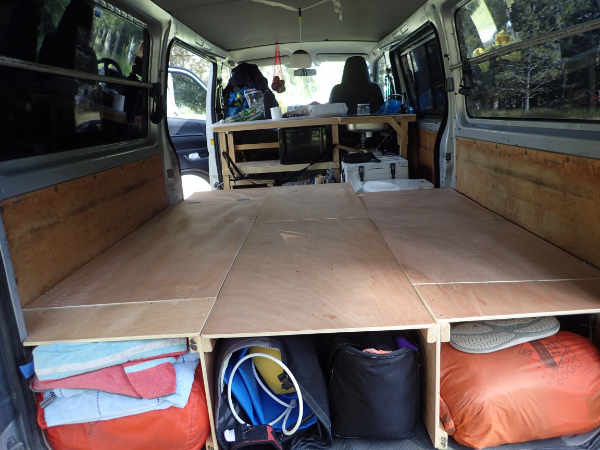By popular demand ... Jumbo!

“Konichiwa, watashi-wa ‘Jumbo’ des-ka.”
Hello, my name is Jumbo, I am Franco and Kath’s campervan. Originally from Japan, I emigrated to New Zealand a few years ago where I found work with an electrician. Life was easy then, I only worked day shifts, drove on smooth tarmac roads and received regular baths. Work was sometimes a bit humdrum, so when the electrician traded me in, I wasn’t too sad. Wow! When Franco and Kath arrived that Saturday morning in my showroom, I had no idea what lay in store. I am now ‘Jumbo the great explorer’, on duty 24/7 and loving it. I may not be as clean as I used to be, and Kath is a terrible windscreen washer, but life is exciting, every day brings a new road or a new adventure (you should have seen some of the tracks I’ve had to negotiate!). My conversion into a self-contained campervan was an experience in itself. When Franco arrived with a handsaw, a hammer, a screwdriver, a set square and a tape measure, I was really frightened, not the high tech laser precision I am used to. Still, we passed the exam with flying colours and the examiner praised Franco’s handywork. It’s been a pleasure to introduce myself.
Konichiwa じゅmぼ
Me
Franco in the Pesda Press mobile office No points for pointing out that the cushion covers aren’t sown up. I was sowing until half midnight the day before the ferry! (Franco says: “you just can’t get the staff these days!”)
Inside without the cushions (the bags in the gap contain the inflatable surfboards)
Storage inside the benches The table is mounted on a removable BBQ stand which unscrews from the floor.
Table removed from stand To make up the bed, we remove the table, unscrew the table leg. Then the table fits between the two storage benches at the back. A purpose made board with a hinged flap fills the gap at the front. One backrest fits between the two bench cushions and the other backrest is laid widthwise supported by the potty and the flap.
The flap (so that the bed doesn’t obstruct the door when not made up)
The bed made up without the cushions
The bed (a full double bed - soooo comfortable)
The ‘house’ battery, to charge the Pesda Press computer The leisure battery is connected with a kit which ensures both batteries are charged when the engine is running but isolated when the main battery voltage drops below 12.8V. The ‘kitchen’ is a removable unit hooked over, and strapped to, a strong bar (which came with the van) behind the front seats.
The ‘kitchen’ The hand pump tap and sink
The fresh and grey water tanks
The very neat waste trap (more steel in the Jubilee clips than in the chassis!)
The ‘fridge’ (a very efficient coolbox - we use a bag of ice every 4 days) and portable potty (so far we’ve only used it once and it didn’t smell) ... And to answer Don’s question about the swivelling chairs, off course!
Chairs - normal position
Chairs - swivelled position They can even be folded and taken to the beach! Now for the technical bit: In New Zealand, ‘self-contained’ means that a vehicle is self-reliant for 2 people for three days. The vehicle must have: - Drinking water - 4 litres of water per person per day = 24 litres - Grey water - a container of the same volume as the drinking water one - Both containers must be opaque and fitted with vents, the grey water tank has to be vented to the outside of the van. They have to be easily removed for filling / emptying. - A sink, attached to the vehicle and fitted with a trap and a leakproof fitting to the grey water tank - A bed - A portable potty, useable with the bed made up, with a capacity of 1 litre per person per day = 6 litres (ours is much bigger!) - A rubbish bin with a secured lid A ‘self-contained’ certificate can be issued by a registered plumber or a self-containment inspector, once they are satisfied that the vehicle meets the standard. |














